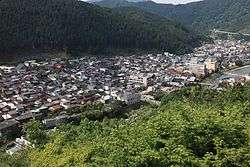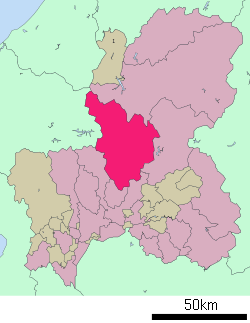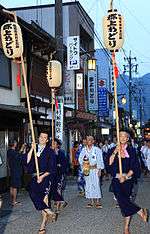Gujō
| Gujō 郡上市 | ||
|---|---|---|
| City | ||
 | ||
| ||
 Location of Gujō in Gifu Prefecture | ||
 Gujō Location in Japan | ||
| Coordinates: 35°45′N 136°58′E / 35.750°N 136.967°ECoordinates: 35°45′N 136°58′E / 35.750°N 136.967°E | ||
| Country | Japan | |
| Region | Chūbu | |
| Prefecture | Gifu Prefecture | |
| Government | ||
| • Mayor | Toshiaki Hioki[1] | |
| Area | ||
| • Total | 1,030.79 km2 (397.99 sq mi) | |
| Population (July 2011[2]) | ||
| • Total | 43,960 | |
| • Density | 43/km2 (110/sq mi) | |
| Symbols | ||
| • Tree | Maple | |
| • Flower | Magnolia kobus | |
| Time zone | Japan Standard Time (UTC+9) | |
| City hall address |
228 Shimatani, Hachiman-chō, Gujō-shi, Gifu-ken 501-4297 | |
| Website |
www | |
Gujō (郡上市 Gujō-shi) is a city located in Gifu Prefecture, Japan.
As of July 2011, the city has an estimated population of 43,960 and a population density of 43 persons per km². The total area is 1,030.79 km².
History
The modern city of Gujō was established on March 1, 2004, from the merger of the towns of Hachiman, Shirotori and Yamato, and the villages of Meihō, Minami, Takasu and Wara (all from Gujō District).[3]
Waterways
Gujō's famous pristine waterways operate the same way as they did in the 17th century. The canals, fountains, and waterways are still used for washing rice, vegetables, and laundry. Townspeople cooperate to keep the canals clean and the water fresh; as a result of their efforts, Gujō's drinking water is a source of local pride.
Gujō Hachiman is in a valley where three major fast-running rivers meet: the Yoshida, Nagara and Kodara.
Visitors come to enjoy the pure mineral water that flows from every tap in town. The clean water and sound environmental practices translate into good food and drink. Ayu, soba, and sake all depend on water for their flavor.[4]
Some residents can be seen using the town's unique system of small waterways to wash laundry and dishes following a very strict set of rules that describe what may be washed where. This practice has survived for centuries and ensures that all households have access to clean water.[4]
Gujō Odori

The famous dance festival — Gujō Odori — attracts many visitors. The festival started over 400 years ago and continues today. During the four days of Obon in mid-August, dances continue all night.
The dance begins on the same night as Kyoto's Gion Festival and continues for 30 nights. It begins at the Yasaka Shrine and moves to another one each night. The Gujō Odori Preservation Society tell musical stories through an "ohayashi" which consists of a soloist, a shamisen, a taiko, and a shakuhachi.[5]
Listeners participate by dancing around the stage. During "Urabon" (August 13 to 16) the dancing continues until 5:00am. More than 20,000 visitors come to town for the odori.[5]
Food replicas
Gujō is a leading producer of food replicas in Japan. Many of the food replicas, used by restaurants to decorate their windows and inform patrons of their dishes, are produced here.
Points of interest
References
- ↑ 市長の部屋. Gujo official website (in Japanese). Gujo city. Retrieved 8 August 2011.
- ↑ 岐阜県の人口・世帯数人口動態統計調査結果. Gifu prefectural website (in Japanese). Gifu Prefecture. Retrieved September 11, 2011.
- ↑ 市政 > 郡上市の紹介 > 郡上市の歴史 > 近代(明治・大正・昭和時代). Gujo official website (in Japanese). Retrieved August 17, 2011.
- 1 2 http://www.gujohachiman.com/kanko/index_e.htm Gujo Hachiman Water
- 1 2 http://www.city.gujo.gifu.jp/english/tourism_and_amusement/ Gujō City tourism and amusement guide
External links
 Media related to Gujō, Gifu at Wikimedia Commons
Media related to Gujō, Gifu at Wikimedia Commons- Gujō City official website (in Japanese)
- Gujō City official website